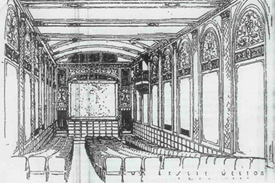Rialto Theatre: Difference between revisions
m (Link date) |
mNo edit summary |
||
| Line 17: | Line 17: | ||
The Rialto closed in the 1930s, a victim of the [[Great Depression]]. The building was next inhabited by the [[Guarantee Shoe Company]], which built a new floor level above the original sloped floor and added Art Deco styled partitions and stairs. | The Rialto closed in the 1930s, a victim of the [[Great Depression]]. The building was next inhabited by the [[Guarantee Shoe Company]], which built a new floor level above the original sloped floor and added Art Deco styled partitions and stairs. | ||
By [[2004]] the building, having been vacant for at least a decade when it had housed "[[Gift World]]", was back up for sale. It was purchased by [[Sam Moore|Sam]] and [[ | By [[2004]] the building, having been vacant for at least a decade when it had housed "[[Gift World]]", was back up for sale. It was purchased by [[Sam Moore|Sam]] and [[Gwyn Moore]] and their son and daughter-in-law [[Chad Moore|Chad]] and [[Chesney Moore|Chesney]] for use as a showroom for their office furniture company [[Moore Solutions]] and as a loft residence for the younger couple. The renovations to the building were documented online in a blog format. | ||
==References== | ==References== | ||
Revision as of 17:36, 25 May 2013
The Rialto Theatre was the fifth motion picture theater built by H. M. Newsome in Birmingham. It was constructed in 1915 on the former site of the Bonita Theater at 1923 3rd Avenue North. The name "Rialto" for the 500-seat theater was chosen by contest.
Newsome purchased the Bonita in 1913, shortly after completing his Trianon Theatre on 2nd Avenue North. Though he already owned three cinemas, he bought the fourth in order to secure local control of the thousands of motion pictures distributed by the General Film Company. Considering the state of the Bonita to be below his standards, Newsome hired architect William Leslie Welton to transform the building into a grand new screening room.
For his $50,000, Newsome obtained a sumptuous Adam-style theater, 30 feet wide and 140 feet deep. "Orchestra style" seats filled the sloping floor. The side walls concealed radiators for heat behind well-proportioned plaster panels. A series of arches framed murals executed in gold, pale green, and "Delia Robbia blue". The cornice at the top of the walls concealed light indirect lighting which reflected off the arched, modeled plaster ceiling. An upper side gallery to the right of the screen was built for Memoli's Orchestra to accompany theatre presentations as well as to entertain patrons in Newsome's adjacent refreshment parlor.
The projection booth, equipped with Simplex projectors, was secured on the second floor so as not to impede any seats, a first for Birmingham. Four exits in the front of the room and two in the rear, along with two generous aisles showed Newsome's sensitivity to issues of safety. The balcony also concealed a large louver through which fresh air was introduced by a 72" fan.
The lobby of the theatre featured marble floors and walls, with ticket office, screen walls, and doorways built of walnut. A bronze-railed marble stair led to the balcony. Wide double doors connected to the adjacent candy store and refreshment parlor already operated by Newsome.
The name "Rialto" was selected by a contest held as part of opening day events on Christmas Day of 1915. The first film exhibited was Maurice Tourneur's Trilby, an adaptation of George du Maurier's Svengali starring Clara Kimball Young and Wilton Lackaye. Ticket prices were fixed at 10 cents.
Between 1927 and 1929 the Rialto installed a "Vitaphone" sound system, which played 16 inch resin discs along with the features as a soundtrack.
Later years
The Rialto closed in the 1930s, a victim of the Great Depression. The building was next inhabited by the Guarantee Shoe Company, which built a new floor level above the original sloped floor and added Art Deco styled partitions and stairs.
By 2004 the building, having been vacant for at least a decade when it had housed "Gift World", was back up for sale. It was purchased by Sam and Gwyn Moore and their son and daughter-in-law Chad and Chesney for use as a showroom for their office furniture company Moore Solutions and as a loft residence for the younger couple. The renovations to the building were documented online in a blog format.
References
- Wilkinson, Kaija (January 27, 2006) "Activity reverses years of decline." Birmingham Business Journal.
- "Newest and Handsomest of Newsome's Theaters Will Be Opened Tomorrow" (December 24, 1915) Birmingham News.
External links
- The Rialto Theatre Renovation website
- Moore Solutions website
- photograph showing the Rialto, c. 1929. Birmingham Public Library Digital Collections
